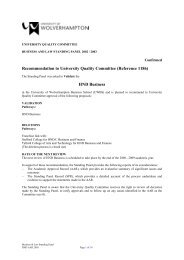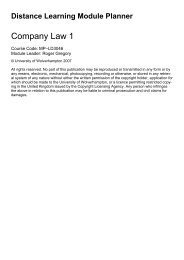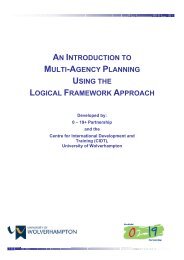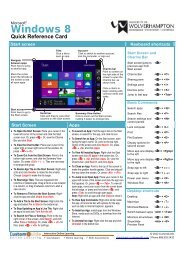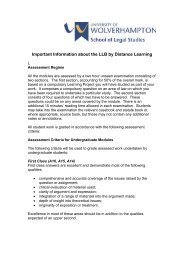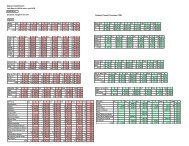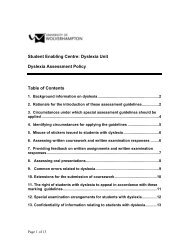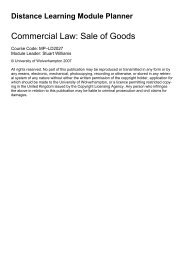This activity can be found in Pretty et al, (1995) - University of ...
This activity can be found in Pretty et al, (1995) - University of ...
This activity can be found in Pretty et al, (1995) - University of ...
- No tags were found...
Create successful ePaper yourself
Turn your PDF publications into a flip-book with our unique Google optimized e-Paper software.
Mt 06 MTF5.2Session 61 Preparation: Cut up the follow<strong>in</strong>g text (without title, footnote, or source) <strong>in</strong>to ‘chunks’ <strong>of</strong> oneor two sentences. Put the strips <strong>of</strong> paper <strong>in</strong>to envelopes: a compl<strong>et</strong>e s<strong>et</strong> for each group <strong>of</strong>participants.Eagles Do Not W<strong>al</strong>k The Stairs(To consider when we t<strong>al</strong>k about learner-centred education)The educator asserted that he had developed his m<strong>et</strong>hods <strong>in</strong> a scientific way. He said that his m<strong>et</strong>hodswere like stairs <strong>in</strong> the house <strong>of</strong> knowledge which could br<strong>in</strong>g learners right to the top. He had madecareful estimates <strong>of</strong> the width and height <strong>of</strong> each step to suit the legs <strong>of</strong> the learners. He had <strong>al</strong>so builtland<strong>in</strong>gs at strategic places where the learners could rest and comfortable banisters which could help the<strong>be</strong>g<strong>in</strong>ners.However, he got very ups<strong>et</strong> one day, not about the stairs which he thought were well planned andconstructed with great wisdom, but with the learners who did not seem to appreciate his efforts.As long as the educator was around observ<strong>in</strong>g how the learners w<strong>al</strong>ked up the stairs, they took a rest atthe land<strong>in</strong>gs and held on to the banister when needed, and everyth<strong>in</strong>g worked as planned. But when theeducator went away – even if only for a short time – there was chaos. Only those who were conditionedto follow <strong>in</strong>structions without th<strong>in</strong>k<strong>in</strong>g cont<strong>in</strong>ued to use the stairs the way the educator wanted – like dogstra<strong>in</strong>ed by their masters. All the other learners <strong>found</strong> ways which corresponded to their <strong>in</strong>dividu<strong>al</strong> needs.One was creep<strong>in</strong>g up the stairs, another took two steps at a time and did not rest on the land<strong>in</strong>gs. Someeven <strong>be</strong>came speci<strong>al</strong>ists <strong>in</strong> w<strong>al</strong>k<strong>in</strong>g the stairs backwards. However, most <strong>of</strong> the learners did not f<strong>in</strong>d thestairs ch<strong>al</strong>leng<strong>in</strong>g or <strong>in</strong>terest<strong>in</strong>g enough. They ran around the house and <strong>found</strong> their own ways. Someclim<strong>be</strong>d up the dra<strong>in</strong> pipe, others clim<strong>be</strong>d with the help <strong>of</strong> the b<strong>al</strong>cony parap<strong>et</strong>s and reached the top withexcitement and <strong>in</strong> no time at <strong>al</strong>l. On the way down they slid on the banisters only to make another try atclimb<strong>in</strong>g to the top.The educator tried to discipl<strong>in</strong>e the learners and force them to follow his guidel<strong>in</strong>es. It never struck himthat there were other ways to reach the top <strong>of</strong> the house such as jump<strong>in</strong>g, runn<strong>in</strong>g or tak<strong>in</strong>g your time to<strong>in</strong>vestigate tot<strong>al</strong>ly new tracks. He never thought <strong>of</strong> a different k<strong>in</strong>d <strong>of</strong> pedagogy which did not try to forceeagles to w<strong>al</strong>k the stairs.2 Give each group an envelope and ask them to work tog<strong>et</strong>her to re-construct the text <strong>in</strong> thecorrect order.3 When the groups have <strong>be</strong>en work<strong>in</strong>g for a while and are start<strong>in</strong>g to make sense <strong>of</strong> the text,qui<strong>et</strong>ly tap one mem<strong>be</strong>r <strong>of</strong> each group on the shoulder and ask them to go and ‘spy’ onanother group for a m<strong>in</strong>ute or two <strong>in</strong> order to compare their responses. They should thenr<strong>et</strong>urn to their own groups and report what they have seen.4 When the groups have f<strong>in</strong>ished, give them a compl<strong>et</strong>e copy <strong>of</strong> the text to check theirsequenc<strong>in</strong>g.5 Briefly discuss participants’ <strong>in</strong>terpr<strong>et</strong>ations <strong>of</strong> the text <strong>in</strong> plenary.74 Jamaica All Age Schools Project: Facilitator Tra<strong>in</strong><strong>in</strong>g for School Based Resource Teachers



